人教版必修4英语Unit3Warming up and reading 教学设计
- 格式:doc
- 大小:5.94 MB
- 文档页数:9
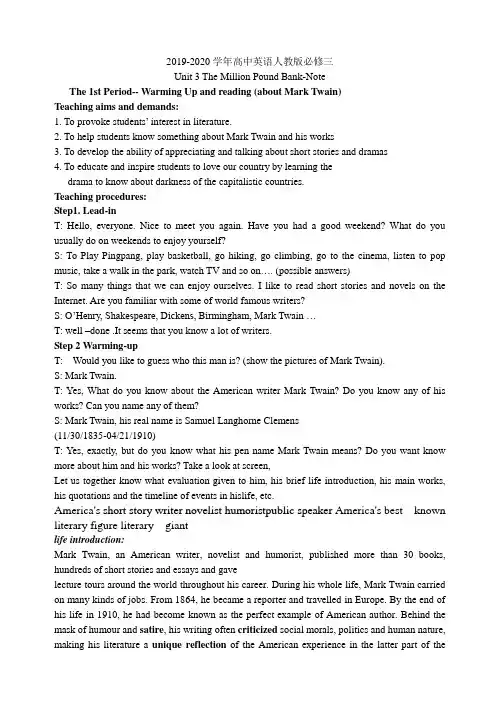
2019-2020学年高中英语人教版必修三Unit 3 The Million Pound Bank-NoteThe 1st Period-- Warming Up and reading (about Mark Twain)Teaching aims and demands:1. To provoke students’ interest in literature.2. To help students know something about Mark Twain and his works3. To develop the ability of appreciating and talking about short stories and dramas4. To educate and inspire students to love our country by learning thedrama to know about darkness of the capitalistic countries.Teaching procedures:Step1. Lead-inT: Hello, everyone. Nice to meet you again. Have you had a good weekend? What do you usually do on weekends to enjoy yourself?S: To Play Pingpang, play basketball, go hiking, go climbing, go to the cinema, listen to pop music, take a walk in the park, watch TV and so on…. (possible answers)T: So many things that we can enjoy ourselves. I like to read short stories and novels on the Internet. Are you familiar with some of world famous writers?S: O’Henry, Shakespeare, Dickens, Birmingham, Mark Twain …T: well –done .It seems that you know a lot of writers.Step 2 Warming-upT:Would you like to guess who this man is? (show the pictures of Mark Twain).S: Mark Twain.T: Yes,What do you know about the American writer Mark Twain? Do you know any of his works? Can you name any of them?S:Mark Twain, his real name is Samuel Langhorne Clemens(11/30/1835-04/21/1910)T: Yes, exactly, but do you know what his pen name Mark Twain means? Do you want know more about him and his works? Take a look at screen,Let us together know what evaluation given to him, his brief life introduction, his main works, his quotations and the timeline of events in hislife, etc.America's s h o r t s t o r y w r i t e r n o v e l i s t h u m o r i s t p u b l i c s p e a k e r America's best known literary figure literary giantlife introduction:Mark Twain, an American writer, novelist and humorist, published more than 30 books, hundreds of short stories and essays and gavelecture tours around the world throughout his career. During his whole life, Mark Twain carried on many kinds of jobs. From 1864, he became a reporter and travelled in Europe. By the end of his life in 1910, he had become known as the perfect example of American author. Behind the mask of humour and satire, his writing often criticized social morals, politics and human nature, making his literature a unique reflection of the American experience in the latter part of thenineteenth century. In the 1890s Mark Twain became very poor. To recover from the bankruptcy, he started a world lecture tour, during which one of his daughters died. The death of his wife and his second daughter darkened his later years.Mark Twain died on April 21, 1910.Time line of the events1835- Haley's Comet welcomed the birth of Samuel Langhorn Clemens. He was born in Florida, MO on November 30. His mom was Jane and his dad was John. He was six of seven kids.1857- The Clemens family moved to Hannibal, MO.1862- Mark Twain's dad, John Marshall died at age 49.1847- 1856- He worked for his brother for newspapers then went to St. Louis, New York City, Philadelphia and Cincinnati to work at a print shop. Then went to help his brothers with the newspaper in Kakoki, Iowa.1858- Mark made his plans to travel to South America, but when he started down Mississippi River, he took a break from the river and went to New Orleans. While he was there, he met Horace Bixby and made him teach him how to be a riverboat pilot.1859- In April, Mark Twain became a licensed riverboat pilot.1863- Clemens began to work for the newspaper in Virginia City, Nevada. This is when he started to use the name, "Mark Twain." Mark Twain means safe water.1866- Twain traveled to Hawaii to write articled in the newspaper. He stayed there for a long while.1870- Samuel thought his writing was better than newspapers and magazines, so he started traveling, writing, and lecturing.1870- Clemens got married to Olivia.1874- Twain moved to Hartford, Conn.1910- Mark Twain died on April 21, in Redding, Conn. From heart disease. Haley's Comet visited again just like the year of his birth.「苦行記」(Roughing It),「密西西比河上的生活」(Life on the Mississippi),「湯姆歷險記」(The Adventures of Tom Sawyer, 1876)、「頑童流浪記」(The Adventures o f Huckleberry Finn, 1884) 、「鍍金時代」(The Gilded Age, 1873)、「海外浪跡」(A Tramp Abroad, 1880)、「王子與貧民」(The Prince and the Pauper, 1882)、「亞瑟王廷之康乃迪克佬」(A Connecticut Yankee in King Arthur's Court, 1889)、「傻威爾遜之悲劇」(The Tragedy of Pudding Head Wilson, 1891)、「聖女貞德回憶錄」(Personal Recollections of Joan of Arc, 1896),The writer’s introduction to The Adventures of Tom Sawyer (1876)Most of the adventures recorded in this book really happened; one or two were experiences of my own, the rest those of boys who were schoolmates of mine. Huck Finn is drawn from life; Tom Sawyer also, but not from an individual —he is a combination of the three boys whom I knew. Although my book is intended mainly for the entertainment of boys and girls, I hope it will not be shocked by men and women, for part of my plan has been to try to pleasantly remind adults of what they once were themselves, and of how they felt and thought and talked, and what strange adventures they sometimes took part in.The Adventures of Tom SawyerThis edition presents Twain's classic American novel in an unabridged text with a reader's guide that's suitable for both children and adults. Mark Twain's classic novel, The Adventures ofHuckleberry Finn, tells the story of a teenaged misfit who finds himself floating on a raft down the Mississippi River with an escaping slave, Jim. In the course of their perilous journey, Huck and Jim meet adventure, danger, and a cast of characters who are sometimes menacing and often hilarious. Though some of the situations in Huckleberry Finn are funny in themselves (the cockeyed Shakespeare production in Chapter 21 leaps instantly to mind), this book's humor is found mostly in Huck's unique worldview and his way of expressing himself. Describing his brief sojourn with the Widow Douglas after she adopts him, Huck says: "After supper she got out her book and learned me about Moses and the Bulrushers,and I was in a sweat to find out all about him; but by and by she let it out that Moses had been dead a considerable long time; so then I didn't care no more about him, because I don't take any stock in dead people." Underlying Twain's good humor is a dark subcurrent of Antebellum cruelty and injustice that makes The Adventures of Huckleberry Finn a frequently funny book with a serious message.His quotation: "Love your enemy, it will scare the hell out of them.”“The man who does not read books has no advantage over the man that cannot read them.”“Always tell the truth; then you don’t have to remember anything.”Humor has been well defined as thinking in fun while feelingin earnest.”幽默被人正确地解释为“以诚挚表达感受,寓深思于嬉笑”。
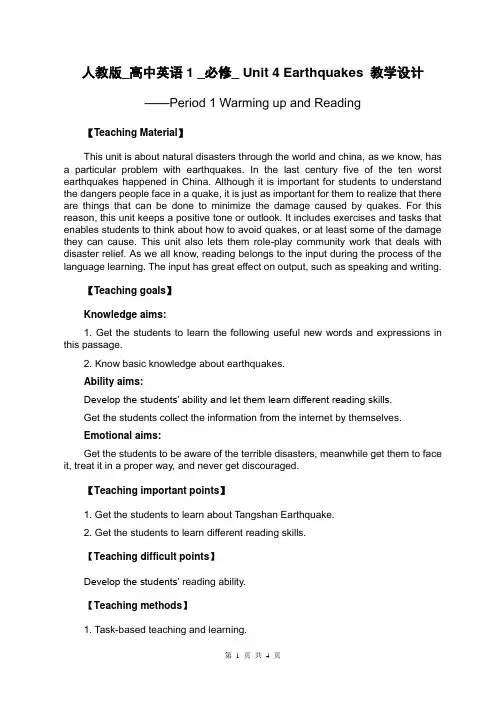
人教版_高中英语1 _必修_ Unit 4 Earthquakes 教学设计——Period 1 Warming up and Reading【Teaching Material】This unit is about natural disasters through the world and china, as we know, has a particular problem with earthquakes. In the last century five of the ten worst earthquakes happened in China. Although it is important for students to understand the dangers people face in a quake, it is just as important for them to realize that there are things that can be done to minimize the damage caused by quakes. For this reason, this unit keeps a positive tone or outlook. It includes exercises and tasks that enables students to think about how to avoid quakes, or at least some of the damage they can cause. This unit also lets them role-play community work that deals with disaster relief. As we all know, reading belongs to the input during the process of the language learning. The input has great effect on output, such as speaking and writing.【Teaching goals】Knowledge aims:1. Get the students to learn the following useful new words and expressions in this passage.2. Know basic knowledge about earthquakes.Ability aims:Develop the students’ ability and let them learn different reading skills.Get the students collect the information from the internet by themselves.Emotional aims:Get the students to be aware of the terrible disasters, meanwhile get them to face it, treat it in a proper way, and never get discouraged.【Teaching important points】1. Get the students to learn about Tangshan Earthquake.2. Get the students to learn different reading skills.【Teaching difficult points】Develop the students’ reading ability.【Teaching methods】1. Task-based teaching and learning.2. Fast reading, intensive reading3. Discussion.【Teaching aids:】CAI课件, A tape recorder【Teaching procedures】Step 1 Warming upWarming up by lookingShow Ss some pictures about natural disasters and ask them two questions.1. Can you tell some natural disasters?(volcano, fire, sandstorm, typhoon, hailstone, thunderstorm, flood, hurricane, earthquake)2. Have you ever experienced an earthquake? Can you describe how terrible an earthquake is?(The earth is shaking; all the buildings will fall down; many people will die; many children will become orphans.)Warming up by discussingNow, look at the pictures of Tangshan and San Francisco in warming up and describe what you see in the pictures.(Beautiful cities; broad roads; tall building; large population...)What will happen if there has been a big earthquake in these two cities?As we all know, earthquakes are disasters to everyone. But can we avoid or at least reduce the loss caused by earthquakes? Can we foretell earthquakes? Now let’s come to Pre-reading and decide what may happen before an earthquake comes.Step 2 Pre-readingImaging and sharingImagine there is an earthquake now. Your home begins to shake and you must leave it right away. You have time to take only one thing. What will you take? Is it money, water, fruits, mobile, phones, a torch light, or anything else? Why?Talking and sharingWhat are the signs of an earthquake? Talk about the pictures on Page 25.(e.g. Cows, pigs and dogs become too nervous too eat. The mice will run out of the fields looking for places to hide. The water in the wells will rise and fall. Walls of the wells in village will have deep cracks. There will be bright light in the sky….) Step 3 ReadingTell the students: Today, we are going to read a news report about the strongest earth-quake in China’s history, which happened in Tangshan, Hebei, in 1976.1. Fast readingAsk the students to read the passage quickly.1) Answer some questions.Ask the students to read the passage quickly and pay attention to the first sentence of each paragraph.2) Find out the topic sentences of each paragraph and get the general idea of the passage.3) Do some true or false exercises.Ask the students to decide whether the following statements are true or false. If it is false, try to correct it.2. Reading carefullyAsk the students to read the passage carefully to lacate particular information.1) Do the exercises in the part Comprehending on Page 27.2) Do some multiple choices.3. Language problemsWhile checking the answers with the whole class,deal with any language problems that the students can’t understand.4. Reading aloudPlay the tape of the passage for the students to listen and follow. Then play the tape of Paragraph 1 of the passage once more; this time the students listen and repeat.Step 4 GameWork in pairs. Supose you are a newspaper reporter, and other is a witness of the 1976 Tangshan Earthquake. Now the newspaper reporter is interviewing the witness.Step 5 DiscussionHow can we protect ourselves in the earthquake?Earthquake Survival TipsDriving --- pull over and stay in your car.In a building--- get near a strong wall / The corner of the room is the safest.Having classes--- listen to the teacher’s instruction, protect their heads and hide under the desks.On buses--- Grasp the handles to avoid being injured; lower the center of gravity; hide near the seats; get off after the earthquake passed.Step 6 HomeworkP review the reading “A Night the Earth didn’t Sleep” and learn new words of this unit.。
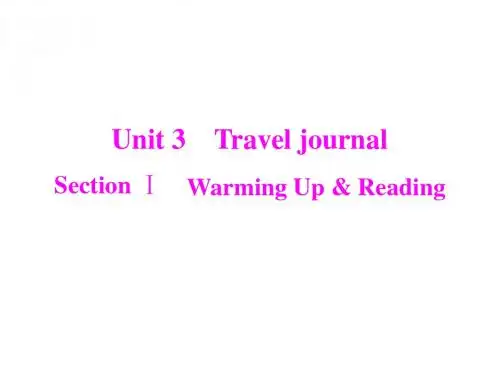
![人教新课标高中英语必修三Unit4_Astronomy全单元详细教案[1]1](https://uimg.taocdn.com/cca11907de80d4d8d15a4ff3.webp)
Unit 4 Astronomy: thescience of the starsContents 目录一、单元教学目标和要求(Teaching aims and demands)二、教材内容分析(Analysis of the teaching materials)三、单元预习任务(Pre-unit task)四、教学安排(Teaching arrangements)五、教学步骤(Teaching procedures)六、背景参考资料(Background knowledge)七、评价与反思(Assessment and reflection)一、教学目标和要求(Teaching aims and demands)根据《英语新课程标准》(实验稿)关于总目标的具体描述,结合高一学生实际和教材内容,我们将教学目标分为语言知识、语言技能、学习策略、情感态度、文化意识五个方面。
1.语言知识(Knowledge)词汇(Vocabulary):能理解、内化、运用以下生词--atmosphere, violent--violence, solid, explode, oxygen, surface, planet, harmful—harm, development—develop, spread, method, presence, telescope, disappointed, force, gradually, float, mass,短语(Phrases and expressions):the solar system, in time, carbon dioxide, prevent… from, depend on, cheer up, now that, break out,功能(Functions):学习掌握一些用于陈述问题及给予意见的结构,如:My problem/ trouble is……? The difficulty / question is…My advice/ suggestion is…What I think about it is…Please pay attention to…Make sure you …Watch out for…语法(Grammar):掌握和运用主语从句。
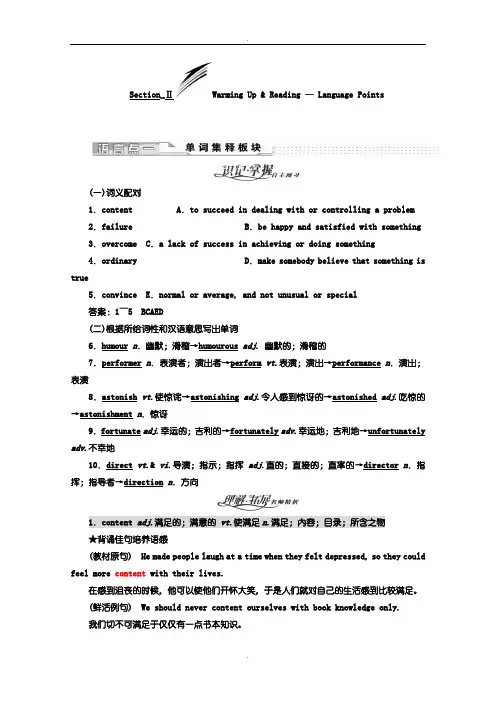
Section_ⅡWarming Up & Reading — Language Points(一)词义配对1.content A.to succeed in dealing with or controlling a problem 2.failure B.be happy and satisfied with something 3.overcome C.a lack of success in achieving or doing something4.ordinary D.make somebody believe that something is true5.convince E.normal or average, and not unusual or special答案:1~5 BCAED(二)根据所给词性和汉语意思写出单词6.humour n.幽默;滑稽→humourous adj. 幽默的;滑稽的7.performer n.表演者;演出者→perform vt.表演;演出→performance n.演出;表演8.astonish vt.使惊诧→astonishing adj.令人感到惊讶的→astonished adj.吃惊的→astonishment n.惊讶9.fortunate adj.幸运的;吉利的→fortunately adv.幸运地;吉利地→unfortunately adv.不幸地10.direct vt.& vi.导演;指示;指挥adj.直的;直接的;直率的→director n.指挥;指导者→direction n.方向1.content adj.满足的;满意的vt.使满足n.满足;内容;目录;所含之物★背诵佳句培养语感(教材原句) He made people laugh at a time when they felt depressed, so they could feel more content with their lives.在感到沮丧的时候,他可以使他们开怀大笑,于是人们就对自己的生活感到比较满足。

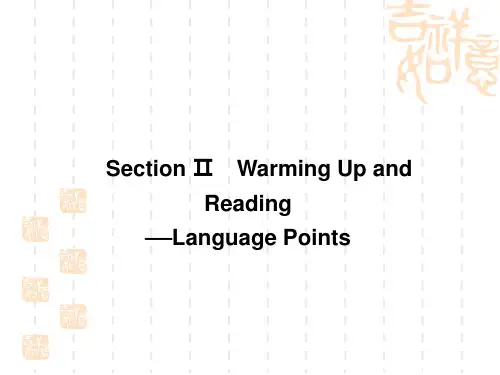
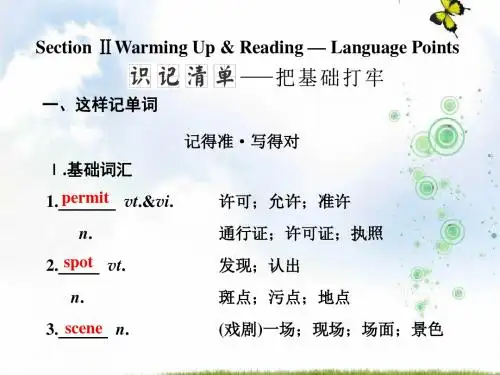
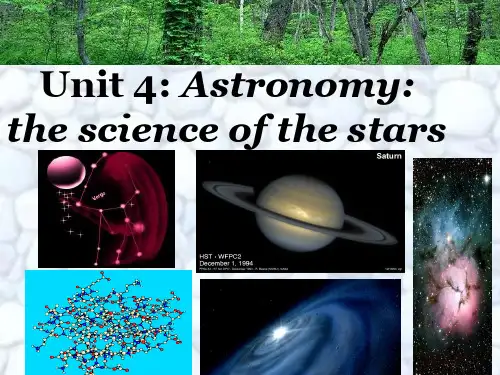
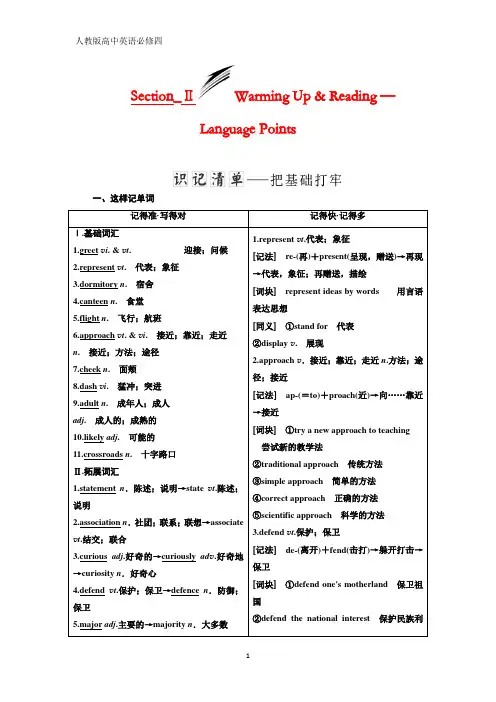
Section_ⅡWarming Up & Reading —Language Points一、这样记单词记得准·写得对记得快·记得多Ⅰ.基础词汇1.greet v i. & v t.迎接;问候2.represent v t. 代表;象征3.dormitory n. 宿舍4.canteen n. 食堂5.flight n. 飞行;航班6.approach v t. & v i. 接近;靠近;走近n. 接近;方法;途径7.cheek n. 面颊8.dash v i. 猛冲;突进9.adult n. 成年人;成人adj. 成人的;成熟的10.likely adj. 可能的11.crossroads n. 十字路口Ⅱ.拓展词汇1.statement n.陈述;说明→state v t.陈述;说明2.association n.社团;联系;联想→associate v t.结交;联合3.curious adj.好奇的→curiously ad v.好奇地→curiosity n.好奇心4.defend v t.保护;保卫→defence n.防御;保卫5.major adj.主要的→majority n.大多数1.represent v t.代表;象征[记法]re-(再)+present(呈现,赠送)→再现→代表,象征;再赠送,描绘[词块]represent ideas by words用言语表达思想[同义]①stand for 代表②display v. 展现2.approach v.接近;靠近;走近n.方法;途径;接近[记法]ap-(=to)+proach(近)→向……靠近→接近[词块]①try a new approach to teaching 尝试新的教学法②traditional approach 传统方法③simple approach 简单的方法④correct approach 正确的方法⑤scientific approach 科学的方法3.defend v t.保护;保卫[记法]de-(离开)+fend(击打)→躲开打击→保卫[词块]①defend one's motherland 保卫祖国②defend the national interest 保护民族利was TonyGarcia fromColombia, closely followed by Julia Smith from Britain. 第一个到达的人是来自哥伦比亚的托尼·加西亚,随后紧跟着的是来自英国的朱莉娅·史密斯。
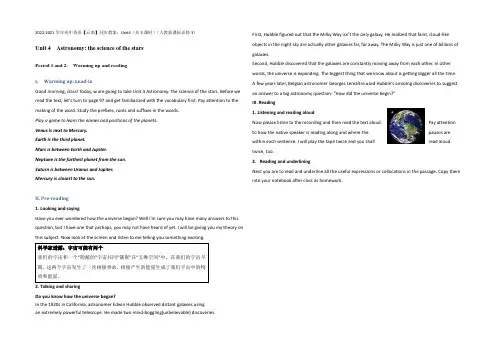
2022-2021学年高中英语【云南】同步教案:Unit4(共5课时)(人教新课标必修3)Unit 4 Astronomy: the science of the starsPeriod 1 and 2: Warming up and readingI.Warming up: Lead-inGood morning, class! Today, w are going to take Unit 4 Astronomy: the science of the stars. Before we read the text, let’s turn to page 97 and get familiarized with the vocabulary first. Pay attention to the making of the word. Study the prefixes, roots and suffixes in the words.Play a game to learn the names and positions of the planets:Venus is next to Mercury.Earth is the third planet.Mars is between Earth and Jupiter.Neptune is the furthest planet from the sun.Saturn is between Uranus and Jupiter.Mercury is closest to the sun.II. Pre-reading1. Looking and sayingHave you ever wondered how the universe began? Well I'm sure you may have many answers to this question, but I have one that perhaps, you may not have heard of yet. I will be giving you my theory on this subject. Now look at the screen and listen to me telling you something exciting.科学家透露:宇宙可能有两个我们的宇宙和一个"隐蔽的"宇宙共同"镶嵌"在"五维空间"中。
Teaching PlanMaking the news —— Warming Up and ReadingMy First Work Assignment “Unforgettable ”,says new journalist(NSEFC Book 5 Unit 4)一. 教学内容本课内容是在单元课题“新闻制作”之下引申出来的关于新闻制作流程以及新闻工作者应该恪守的职业操守的话题。
作者通过“我”(周阳)的7个提问,以周阳的领导胡新的回答为诠释,陈述了一个新闻工作者应该如何学习团队合作,如何获取准确的新闻,以及如何保护新闻免受指责。
二. 教材处理本课是这个单元的第一课时,词汇知识为全新内容,在课前通过黄晓明与Angelababy 结婚的新闻内容,将新词串联,以此完成词汇教学。
通过Skimming ,让学生快速发现文体,找出时间、地点、人物、事件,发现篇章结构,完成分段,并进行快速的文章小结。
在Scanning 部分,将全文以周阳的笔记的形式呈现,按照分好的段落,对重要内容进行挖空处理,让学生获取、分析和填写信息。
在对课文内容有具体的了解之后,让学生完成“七选五”练习,从而对文章整体结构有更加深刻的理解。
作为课文难点,新闻行业的专业术语在“七选五”练习中被呈现,并以连线题的方式让学生进行意义匹配。
三. 教学目标a) 语言知识目标: b) 语言技能目标: c) 情感态度目标:引导学生思考新闻工作者的职业道德,引导学生做一个尊重事实、诚实的人。
d) 教学重点和难点:教学重点:使学生了解文章大意,理清作者思路,掌握基本阅读技巧(skimming ,scanning ),掌握篇章框架阅读的方法。
教学难点:让学生1.理解新闻专业术语的意思。
2. 学会将关键词连成一句话新闻,最终实现语言输出。
重点单词: journalist ,photographer ,designer ,editor ,delighted assistant ,professional , acquire , dilemma② 重点短语: concentrate on, accuse sb. of sth., cover a story , concentrate on be eager to, accuse sb. of sth, depend on ①能运用扫读与寻读的阅读技巧快速获取信息。
人教版英语精品资料Section_ⅡWarming Up & Reading — Language Points(一)词义匹配1.atmosphere A.a group of related parts which work together forming a whole 2.system B.the mixed gases that surrounds the earth3.fundamental C.for that reason; for this reason4.theory D.increase, add to the number of5.thus E.very important or necessary6.multiply F.idea that tries to explain something答案:1~6 BAEFCD(二)用所给词的适当形式填空7.A big violent (violence) earthquake occurred last week.8.Being exposed to the sunlight for a long time will be harmful (harm) to one's skin.9.Unlike (like) his brother, he is talkative (健谈的) and has a sense of humour.10.The puzzling(puzzle) problem made students present puzzled (puzzle).1.violent adj.猛烈的;激烈的;强暴的★背诵佳句培养语感(教材原句)The earth became so violent that it was not clear whether the shape would last or not.地球(开始)变得激烈动荡,不知道这个固体形状是否会继续存在下去。
高中英语学习材料***鼎尚图文理制作***Unit 4Astronomy:the science of the stars训练一Warming Up and ReadingⅠ.写出下列单词的正确形式1.violence ______(形容词)2.religious ______(名词)3.like(prep.)______(反义词)4.harm______(形容词)5.astronomer______(名词:天文学)6.explode______(名词)7.disappear ______(名词)8.global______(名词)9.develop______(名词)10.existence______(动词)Ⅱ.把下列短语译成英语或汉语1.in all directions ______2.______及时;迟早3.cool down______4.______也,又;和……一样好5.lay eggs ______6.______ 产生;分娩7.in one's turn______8.______ 阻止;制止9.as a result of...______10.______ 依靠;取决于Ⅲ.单词拼写1.As we climbed up the mountain,the dangers and difficulties ______(增加).2.A solution has not yet been found to the ______(基本的)problems of industrial relations. 3.The gas given off by automobiles is h______ to people's health.4.The present ______(制度)of education needs to be improved.5.It seems good in t______,but it doesn't work in practice.6.Will you help me with this crossword p______?It got me stumped.7.The a______ of the city is very much polluted.8.With the d______ of modern agriculture and industry,our everyday life has improved a lot. 9.G______ speaking,girls are better at learning to speak languages than boys.10.The Chinese government did very well in p______ SARS from spreading.答案:Ⅰ.1.violent 2.religion 3.unlike 4.harmful5.astronomy 6.explosion7.disappearance8.globe9.development10.existⅡ.1.四面八方 2.in time 3.冷却下来;冷静4.as well as 5.下蛋 6.give birth to7.轮到某人;接着8.prevent...from9.由于10.depend onⅢ.1.multiplied 2.fundamental 3.harmful4.system 5.theory 6.puzzle7.atmosphere 8.development9.Generally10.preventing课堂巩固Ⅰ.阅读HOW LIFE BEGAN ON THE EARTH,回答下列问题1.How were stars and other bodies created?A.Atoms combined to create them.B.Clouds of dust combined to create them.C.Water combined to create them.D.Gases combined to create them.2.Which is the most important for life appearing on the earth?A.Fire.B.Rock.C.Water. D.Clouds.3.It can be known from the passage that ______.A.plants and animals appeared on the earth at the same timeB.plants appeared later on the earth than animalsC.early shellfish appeared earlier than plantsD.animals appeared later on the earth than plants4.How many years did dinosaurs exist on the earth?A.More than 140 billion years.B.More than 140 million years.C.More than 140 thousand years.D.More than 140 years.5.Why can the earth become too hot to live on?A.Small clever animals produce more heat.B.Small clever animals produce too much carbon dioxide.C.Small clever animals don't want heat to escape from the earth.D.Small clever animals like to live in a hot planet.Ⅱ.用方框里短语的正确形式填空1.—Did you catch your plane?—Yes,we got there just__________.2.The dish tastes good after it______.3.We are repairing the roof ______painting the walls.4.—Will you go fishing this afternoon?—Well,it all ______the weather.5.Lacey has a back injury that may __________her ______playing in tomorrow's game.6.When school began last summer,most of us met __________.7.Mice scattered __________ when a cat appeared.8.__________ teamwork,they finished the task ahead of time.9.She __________ a fine healthy baby last night in this hospital.10.The soldier managed to __________ the enemy's prison.Ⅲ.选词填空(in time,on time,in no time,at one time,at times,at any time)1.—Why are you in a hurry to leave here?—To get home ______ to bathe the children.2.These buses are never ______ and the passengers are always complaining.3.While I am away,please call me ______ if someone comes to see me.4.You can't imagine this lake used to be a beautiful place in our province ______.5.He rushed out of the kitchen ______ when he heard the shout.6.______ I sit silently and wonder if this kind of job is worth all the effort.答案:Ⅰ.1.A 2.C 3.D 4.B 5.BⅡ.1.in time 2.cools down 3.as well as 4.depends on 5.prevent;from 6.for the first time7.in all directions8.As a result of 9.gave birth to10.escape fromⅢ.1.in time 2.on time 3.at any time4.at one time 5.in no time 6.At times提示:in time“及时”;on time“按时”;in no time“立即,马上”;at one time“曾经”;at times=sometimes“有时”;at any time“在任何时候”。
必修四Unit 3 A taste of English humor说课稿各位老师:大家下午好,我是来自,非常荣幸能够在这里与大家分享我的一节课,我这节课的内容是高中英语必修四第三单元A taste of English humor的Warming-up和Reading部分。
我准备从以下6个方面来展开我的课:教材分析、教学目标、教学方法、学习方法、教学步骤、教学反思。
第一部分:教材分析本单元是关于不同类别的英式幽默,通过学习本单元,能够让学生了解Charlie Chaplin 滑稽但是却鼓舞人心的幽默,本单元阅读部分不但能让学生了解到关于Charlie Chaplin的相关信息,同时也能够让学生通过本篇课文,提高英语学习的能力。
第二部分:教学目标众所周知,阅读在英语学习的过程中属于语言的输入过程,而语言的输入过程又对语言的输出过程,比如说和写又有很大的作用,那么,在研究完新课程标准和教学大纲后,我的教学目标将会是知识目标、能力目标、情感目标。
1. 知识目标学生能够听懂,读懂,并且能够正确地使用文中重点的单词,短语重点单词:humor content astonishing unfortunately ordinary bored entertain throughout homeless worn failure overcome leather chew convince convincing direct outstanding 重点短语:up to now, badly off, pick out, cut off, star in学生能够理解文章的内容2.能力目标增强学生的听,说,读,写能力,尤其是说和写的能力训练学生共同协作的能力增强学生阅读能力,尤其是跳读和精读的能力3.情感目标通过本文,学生能够从Charlie Chaplin那学到乐观面对生活的苦难,并且能够自己去发掘我们生活中的幽默第三部分:说教法英语教学过程中最重要的是什么呢?我认为最重要的莫过于如何让学生读懂文章,并且能够让他们将课文中重要的单词或短语能够自由的在日常生活中使用。
Unit3 warming up 名师教学设计
Unit3 A Taste of English Humor
I.Teaching aims
1. Knowledge goals
①Get students to brainstorm some important useful words related to humor, such as h umorous, humorist, optimistic, relaxed, sketch, cross talk, tongue twisters, mime, com edy, nonverbal etc.
② Enable students to learn to appreciate different types of humor in our daily life, esp ecially have a good understanding of English Nonverbal humor
③ Get students to read the passage and to learn about a master of nonverbal humor--- Charlie Chaplin and develop different reading skills.
2. Ability goals
① Let students learn to find and enjoy humor to make their life easy and happy and enable students to talk about types of humors and Charlie Chaplin
② Develop students’ reading ability and let them practice different reading skills
3. Moral goals
①Develop students’ sense of cooperative learning.
② Inspire students to keep an optimistic attitude toward life, and overcome them with confidence .
③Cultivate students’ good sense of humor
II.Teaching important points
① Let students have a good command of English humor
② Help students grasp the reading skills to get information, analyze the information a nd understand the information from the text.
III.Teaching difficult points
①How to fire students’ enthusiasm to express their ideas.
②How to make students grasp the reading skills to get information, analyze the infor mation and understand the information from the text
IV.Teaching methods
①Communicative approach
②Task-based teaching method
③ Audio-visual method
V.Teaching aids
A mufti-media classroom.
VI.Teaching procedures
Step1. Lead-in
1. Show some funny pictures
【设计说明】图片能吸引学生注意力,从而调动他们学习的积极性,从而引出这节课的主题——— Humor, 并引出What is humor?的思考。
2.Understanding of humor. What is Humor?
Brainstorm the words to stand for each letter of humor and share Victor Hugo’s under standing of humor.
【设计说明】“头脑风暴”进一步营造宽松和活跃的课堂气氛,充分调动学生的学习积极性,激活学生的思维,培养他们的发散思维能力。
四人小组讨论将答案尽可能多地写在纸条上,然后交流汇报,实现资源共享,同时引入Victor Hugo的一句名言,加深对humor的内涵的理解。
3.A discussion on types of humor
【设计说明】通过“Kinds of humor”的讨论,一方面拓展延伸了对humor的掌握,另一方面引人本单元主题A taste of English humor.
Step2. Warming Up
1. Two English verbal jokes and what is “punchline”?
Enjoy a video --- a nonverbal humor by Mr.Bean
【设计说明】通过two English verbal jokes 理解punchline, 通过Mr.Bean的表演展示nonverbal humor 的魅力,一方面对“Kinds of humor”进行举例,另一方面引出另一位Nonverbal humor 大师---- Charlie Chaplin.
Step3. Reading
1.Prediction
【设计说明】通过Prediction环节理解,培养学生对文章的预测能力。
同时,假设自己是作者去构思如何描写人物,既培养学生对文章内容与结构的分析能力又有助于学生以后写作中的布局谋篇能力的提升。
而且通过
Will these information mentioned in the text?衔接下一步教学。
2.Scanning and having a quick glimpse of Charlie Chaplin
【设计说明】通过Scanning阅读技巧,快速查找信息。
培养学生找关键词的能力。
3.Listening &Matching
【设计说明】通过听读训练,快速掌握文章主旨和结构。
4.Careful Reading
【设计说明】通过阅读,推断What personalities did Charlie Chaplin show?
并把学生的答案板书展示,以便最后总结人物总体性格时更加直观。
【设计说明】通过Fill in the blanks,快速查找关键词,并总结人物性格特点,快捷有效的利用课堂,并积极与学生进行互动,增强课堂的灵动性。
【设计说明】通过the little tramp 的人物肖像,和快速描述其外貌特征及性格特征,并通过How the little tramp made a sad situation entertaining?引入下一环节the little tramp 在The Gold Rush中的精彩表演。
【设计说明】通过视频,不但更加直观有效展示和论证Charlie Chaplin的幽默,而且能有效调动课堂气氛。
而且在欣赏视频后,对其表演动作行为进行描述,进一步加深Charlie Chaplin’s sense of humor 的理解。
最后通过
“Could you make a comment on his acting?”培养学生的对事物的分析及评价能力。
【设计说明】通过填空和图片,快速展示Charlie Chaplin的成就,并引发思考“Does Charlie Chaplin’s success come by chance?”并结合板书中对Charlie Chaplin
的personality的探讨,帮学生形成对Charlie Chaplin的更全面深入的认识。
5.Mind-map Summary
【设计说明】
通过mind-map,直观有效地对全文进行归纳总结。
同时激励学生无论遇到任何困难都要像Charlie Chaplin一样optimistic。
Step4. Assignment
Write a comment on Charlie Chaplin within 120 words.
【设计说明】深入对Charlie Chaplin的理解,并培养学生对文本材料的评价写作能力。
Blackboard design。